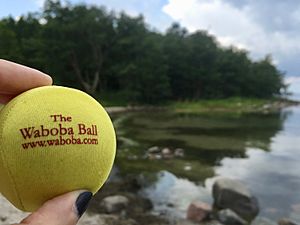Waboba facts for kids
Waboba is a company from Stockholm, Sweden, known for making cool outdoor toys and sports gear. They are most famous for inventing special balls that bounce on water! They also make the super bouncy Moon Ball and the Wingman flying disc. Waboba focuses on toys for the beach and backyard. Their motto is Keep Life Fun.
Contents
What Does "Waboba" Mean?
The name "Waboba" is actually a short way of saying "water bouncing ball." This name comes from the very first toy the company invented!
How Waboba Started
The Idea for a Bouncing Ball
Back in the early 1980s, in Sweden, a clever inventor named Jan Von Heland had an idea. He was throwing a Frisbee upside down and saw it skim across the water, much like skipping a flat stone. This made him wonder if he could create something that would bounce on water.
Developing the Ball
For many years, Jan tried out different shapes and materials. Finally, in 2002, he discovered that a ball could bounce really well on water if it was soft and covered with a special fabric called Lycra. This design helps the ball glide smoothly over the water. In 2004, Jan created the plan to sell these water-bouncing balls, and he even got a patent for what became the Waboba Ball.
How the Ball Works
The Waboba ball is made from different types of soft plastic called polyurethane, covered in Lycra. This allows it to bounce on water and also float. To make it bounce, you throw it like you're skipping a stone. If you throw it with enough force and at the right angle (overhand), it will bounce high between players on the water! These balls are special because they don't bounce on land.
Different Types of Waboba Balls
Today, there are many different kinds of Waboba balls. Some popular ones include:
- Pro: Designed for players who want good control and accuracy in lakes or the ocean.
- Extreme: This one bounces fast, far, and high in lakes or the ocean.
- Surf: Great for beginners because it's soft and easy to handle in the water.
- Big Kahuna: The largest Waboba ball, perfect for lakes, oceans, and pools.
- Blast: Made especially for playing in swimming pools.
- Fetch: A special ball designed for dogs to retrieve from the water.
Waboba on TV
On April 1, 2016, Waboba and Jan von Heland's invention were featured on The History Channel's show Million Dollar Genius.
Where Waboba Products Are Sold
The Waboba Water Bouncing Ball first came out in Sweden in 2005. After two years, it was introduced to other countries like Europe, the United States, and Australia in the summer of 2007. As of 2025, you can find Waboba products in over 75 countries around the world!
Other Waboba Products
Besides their famous water-bouncing balls, Waboba also makes other fun items:
Water Accessories
- Catch: A special glove made of neoprene that you can wear to help catch the Waboba Pro ball during water games.
- Waboba Lacrosse: In 2014, Waboba teamed up with STX to create a water lacrosse game. It uses special FiddleSTX sticks and a Waboba Extreme ball.
- Water Cracket: A cricket bat designed to be used with a water bouncing ball.
Land Toys
- Moon: A super high-bouncing ball designed for land.
- Street: This ball has an unusual shape, which makes it bounce in unpredictable ways.
- Flyer: An oversized shuttlecock that you can hit with your hands, knees, feet, or even rackets.
- Wingman: A flying disc made of silicone that can be folded up.
Awards Waboba Has Won
Waboba products have received several awards, including:
- Special Needs Approved by AblePlay
- Dr. Toy Best Toy for Vacation
- Gold Award from Family Review Center
- Moon Ball 2013 Toy of the Year Award winner by Creative Child Magazine
The Science Behind the Bounce
How Water Balls Bounce
When a Waboba water ball hits the surface of the water at a shallow angle, it flattens out a bit, almost like a pancake. This flattening helps it glide across the surface. As it moves, it creates a small, bowl-shaped dip in the water. This dip then helps to launch the ball back into the air, making it look like it has bounced! Once in the air, the ball quickly returns to its original shape.
This process is very similar to how flat stones skip across water, even though stones are much heavier than water. When a stone hits the water at a low angle, it also creates a small dip that pushes it back up into the air.
Scientists working with the U.S. Navy have even studied Waboba balls! They are interested in how the ball's softness and flexibility affect its movement in water. They want to learn more about how different materials behave when they interact with water.
It's important to know that many types of balls can skip on water if they are thrown at a low angle and with enough speed. This is because of a principle called hydroplaning, where an object glides on a thin layer of water.
This idea of bouncing objects on water was even used during World War II by a British inventor named Barnes Wallace. He developed the "bouncing bomb" for a famous mission. He got his idea from old stories about the British navy, who would bounce cannonballs off the ocean surface to hit enemy ships. Wallace figured out the science by bouncing marbles and other balls across ponds. Even solid steel balls can bounce across water if thrown correctly!


